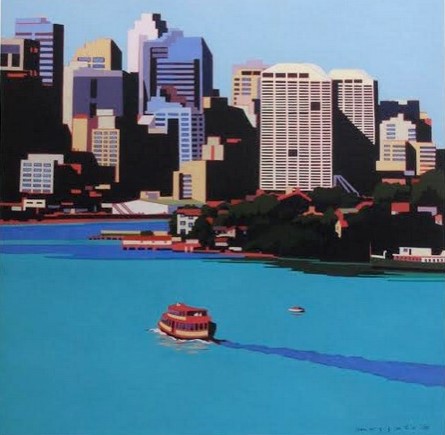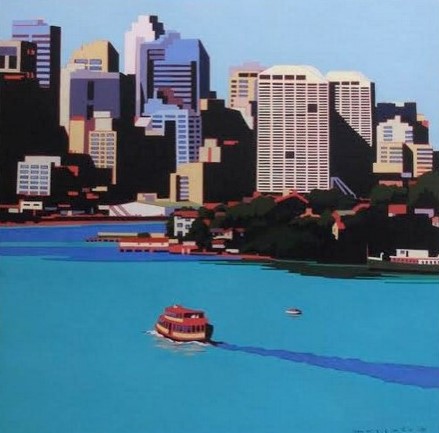____________
Laurie Mossuto’s City Trip captured my attention the moment I saw it! While it’s visual attributes are many and varied, the concise subject matter brings myraid social contexts into play.
____________
Trying to understand why an image both moves you and secures your attention will depend on the whole of your life’s experience: a dramatic phrase, nevertheless self-evidently true. And yet, for most of us, the information the image imparts will be difficult to articulate in terms of that life experience.

___________
You might immediately acknowledge that the internal aspects of City Trip seem perfectly balanced and arresting, still, in terms of interpreting art, you have difficulty fully understanding what those attributes are – or indeed the feeling or expression that emanates across the gallery divide to you. Why does it make this impression upon you? The reason results partly from the unique qualities that only your life has been subject to, as well as the skill of the artist to make a succinct statement about a subject. And don’t forget that all statements are socially embedded and contextualised. Just like your life’s experience so too the artist brings the whole of their life’s experience to the organising principles of the image.
When viewing an image, and why it works so well is a bit like going on a treasure hunt with a map of clues. The image gives us clues as to why it generates formal(1), technical and social impact (historic, psychological, anthropological etc). However, whilst it will comprise all of those things to a greater or lesser extent, and much of the visual information the image imparts will be acknowledged by all viewers, the individual details and how they come together and present to you will be peculiar to your specific history.
As mentioned above, there are myriad reasons for this:
- The slightly elevated viewpoint (the viewer is positioned so that we look down and across the image), enhancing the fact that the individual elements make up a ‘big picture’. The diminutive boat (a ferry) is a small craft on a large body of water against a monumental complicated urban backdrop. The elevated viewpoint also enables the artist to articulate distance in detail to amplify the size of the boat and it’s imminent arrival in ‘the big city’.
- The striking visuals are down to complex yet simplified geometries and palette: dark shadows, as well as graphic buildings, landscape, pictorial divisions. It is easy for the viewer to immediately appreciate the components in the image because they are geometrically abstracted.
- The composition is balanced in terms of colour (notice the range of tonal blues unifying the image), objects, urban and landscape elements, enhanced by the simple tiered palette, and clear graphics. Undoubtedly due in part, to Mossuto’s early career as a graphic artist.
- Compositionally, the image appears as an inverted triangle or pyramid. The viewer’s eye falls immediately on the ferry and its wake, sweeps up left-to-right and back to the boat. This circular movement enforces an intellectual realisation; the boat as a ferry will invariably be arriving and leaving regularly, forward and back, around and around on its daily traverse. The subject and main components of the print prosecute a binary of particular to general and the reverse: the ferry collects individuals from specific suburbs and transports them to the general CBD where the individuals become part of the generalised masses. At the end of the day the ferry takes the masses back to individual homes and suburbs.
- Reiterating too, the palpable sense of the little boat, bobbing along, always at the mercy of the ocean, juxtaposed with an established, significant and immovable cityscape. Extrapolating, the purposeful little ferry – transports the people on board, to and fro, day-after-day, about to be swallowed up by infrastructure. The unique identities of the people on board the ferry become invisible as one among the masses in the city.
At a glance, the print subject matter embraces a plethora of opposites: the ferry populating the city with workers (and the opposite at the end of the day), small versus big, simple versus complex, insignificant versus important, tenuous versus substantial, old versus new and many more.
These aspects not only make it relatable and self-assured, but lie at the heart of the charismatic punch City Trip imposes on the viewer.
__________________
Thanks Kim! A very impressive interpretation! Laurie Mossuto
__________________
Laurie Mossuto, City Trip, Giclee print on archival paper, 2015, original 60 x 60cm, Edition: 5/50
(1) Formal: colour, tonal values (eg: dark to light),texture, line, movement, object dimensions,
Available from Walcha Gallery of Art






















